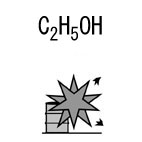| Case Name |
Explosion of ethanol vapor caused due to insufficient exhaust during drying operation of vitamin tablets at a pharmaceutical factory |
| Pictograph |

|
| Date |
July 3, 1998 |
| Place |
Gifu, Gifu, Japan |
| Location |
Pharmaceutical factory |
| Overview |
At a pharmaceutical factory, ethanol evaporated in the drying process for vitamin tablets exploded by electric sparks. The cause was that the ventilator of the drier did not work because someone had forgotten to turn it on or there was an electric problem. Therefore, evaporated ethanol was ignited by electric sparks from the drier. Insufficient management such as lack of daily checks or periodic inspections might have caused the accident. |
| Incident |
After materials of vitamin tablets were kneaded in a pharmaceutical factory, ethanol was evaporated to make products. As a ventilator of a drier for non-hazardous materials was not working, accumulated ethanol vapor exploded by electric sparks. |
| Processing |
Manufacture |
| Individual Process |
Drying and desiccation |
| Substance |
Ethanol, Fig2 |
| Type of Accident |
Explosion |
| Sequence |
08:40 on July 3rd, 1998. Each raw material was measured to manufacture vitamin tablets.
09:30. Materials were kneaded together.
10:00. Kneaded materials went into a granulating machine and became cylindrical granules. They were laid on 17 net plates.
10:10. 17 net plates were put on an exclusive cart, carried to a drier in the next room, and the drying process started.
11:14. An explosion occurred in the drying room and five operators were injured. Fire extinguishing work was done immediately. |
| Cause |
Although the drier being used was only for the products, it was not for hazardous materials. Therefore, the ventilation facilities were attached independently. However, it was not working because someone had forgotten to switch it on or due to an electrical failure. Besides, as dust and dirt accumulated, a natural exhaust was not made effectively. For this reason, the evaporated ethanol leaked out from the drier, ignited by electric sparks from the drier or its operation board, and exploded. |
| Response |
Fire extinguishing work. |
| Countermeasures |
Daily checks, cleaning, and periodic inspections are carried out properly.
Explosion-proof electric devices have to be used.
An explosion door should be installed in the drier of a hazardous material.
The person who has responsibility for the drier has to be assigned, and management should be clarified.
Preparation of operation standards, and safety education for employees. |
| Knowledge Comment |
Although ethanol is considered to be a familiar substance in a pharmaceutical factory, an inflammable mixture is generated at room temperature.
A conventional drier must not be used for drying goods containing a flammable substance.
It is necessary to use a drier equipped with an explosion door etc. for hazardous materials. |
| Background |
Based on the following factors, the cause is considered to be a lack of consciousness of safety management. This must be management responsibility.
Daily checks, cleaning, and maintenance were hardly performed for the drier, ventilator, etc.
Periodic self-regulated inspections were not executed.
Safe education for dealing with a hazardous material was inadequate.
Operation standards existed, but were not well known to the operators.
Operation standards at the time of abnormalities were not prepared. |
| Incidental Discussion |
Because a methanol flame is hard to see, cautions are required. |
| Reason for Adding to DB |
Example of explosion caused due to no care on hazardous vapor |
| Scenario |
| Primary Scenario
|
Poor Value Perception, Poor Safety Awareness, Inadequate Risk Recognition, Organizational Problems, Poor Management, Poor Operation Management, Carelessness, Insufficient Precaution, Carelessness of Operator, Planning and Design, Poor Planning, Poor Operation Planning, Malicious Act, Rule Violation, Safety Rule Violation, Bad Event, Electrical Failure, Breaking of Wire, Secondary Damage, External Damage, Leakage/Fire, Bodily Harm, Injury, 5 person injured
|
|
| Sources |
Outline of significant accidents. Safety yearbook 1998, p.274.
The Res. Inst. of Industrial Safety material. (closed).
|
| Number of Injuries |
6 |
| Multimedia Files |
Fig2.Chemical formula
|
| Field |
Chemicals and Plants
|
| Author |
ITAGAKI, Haruhiko (Japan National Institute of Occupational Safety and Health)
TAMURA, Masamitsu (Center for Risk Management and Safety Sciences, Yokohama National University)
|
|